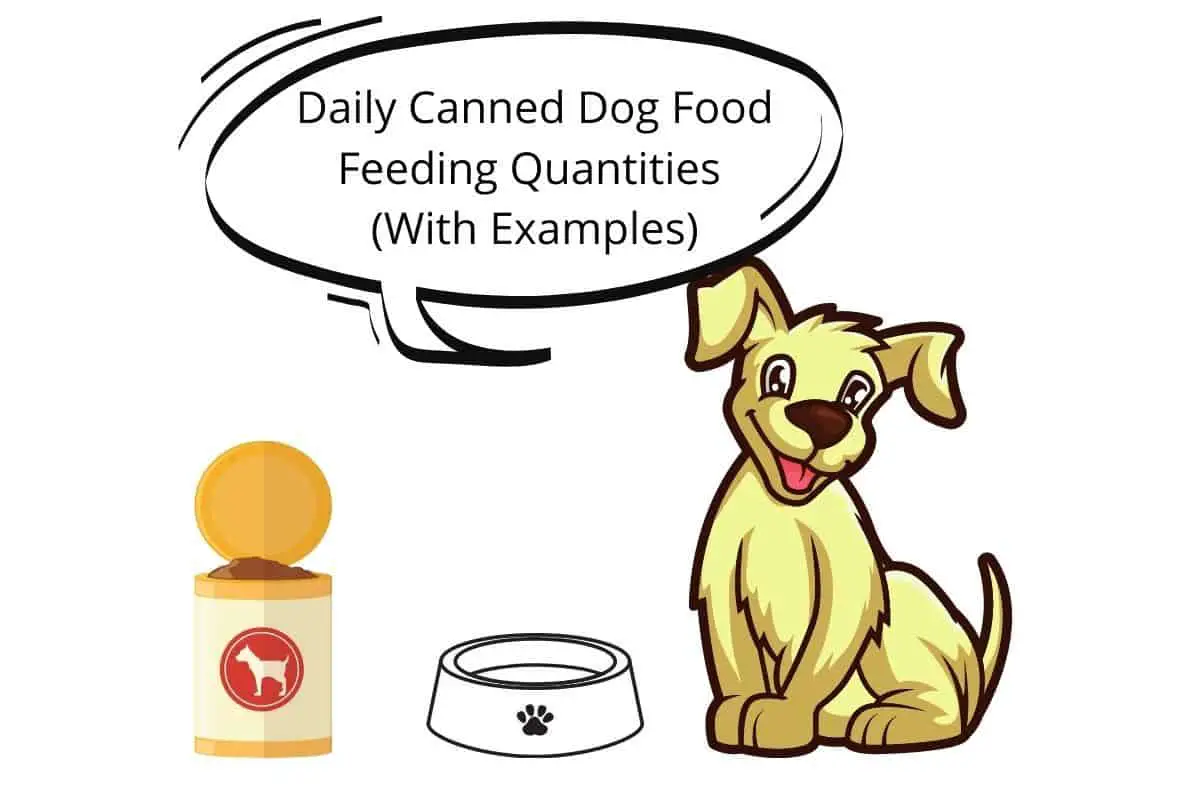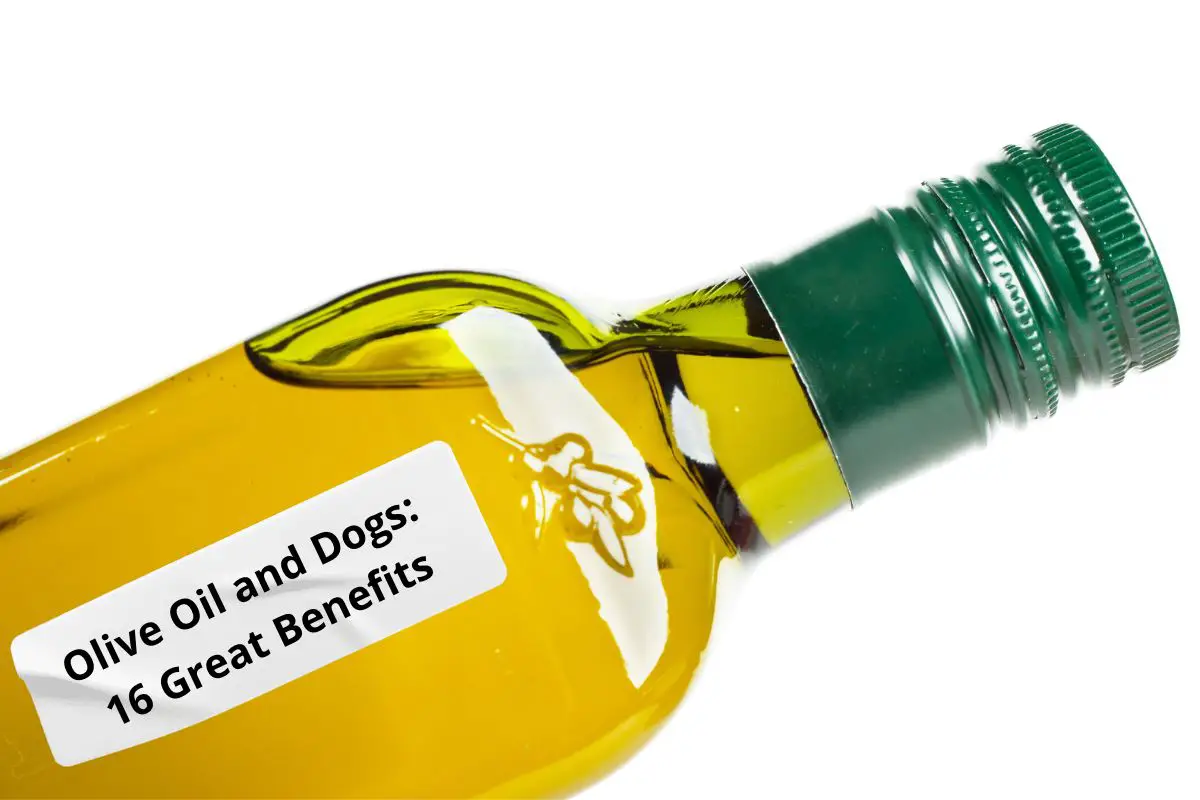This post contains affiliate links.
With such a wide variety of pet food products and brands, owners are easily confused about which food is best for their dogs. Canned wet food varieties have many advantages over the traditional kibble-style dog food and are tasty, nutritious, and easily digested. However, it’s sometimes difficult to gauge exactly how much canned food you should feed your pet.
Daily canned dog food feeding quantities vary according to your dog size, condition, and activity levels. Puppies and lactating dogs require a higher caloric intake, and you must factor in your dog’s individual needs. Generally, feed your dog about 3 oz. for every 3-3.5 pounds of body weight.
It’s essential to research your intended wet food product to give your dog the correct amount of canned food. Choosing the right product will ensure that you provide the proper nutritional value to your dog’s unique needs. If you’d like to learn which daily canned food quantities are suited to your pet and examples of some top canned foods, read on.
Table of Contents
What Daily Quantity of Canned Food Should I Feed My Dog?
Calculating the correct amount of canned food to feed your dog is a precise process. That’s because every dog is unique, and the calorie content of your canned food may vary considerably between different brands and life stage formulas.
The product must provide a feeding quantity guideline, which may be your starting point in discovering the correct amounts.
However, finding perfectly balanced feeding quantities for your pet must factor in the following.
Factors Influencing Food Quantity
Your canned food manufacturer may not take into account a few factors when setting their recommended feeding quantities. That’s why, often, owners will make a feeding plan based on:
- Type of food
- Number of meals
- Bodyweight
- Metabolic rate
- Amount of exercise
Your Dog’s Lifestyle
When a manufacturer states that two tins provide adequate nutrients by weight, owners should consider that this is just a baseline quantity. For example, I may have a 35-kg (77.16-lb) Staffordshire Terrier who is older and only walks three times a week or a 35-kg (77.16-lb) Collie who exercises twice a day vigorously. These two dogs are both the same weight but have very different caloric requirements.
Your Dog’s Age
Dogs have particular requirements that evolve through their stages of life and growth. Older dogs are typically less active and require a lower caloric intake. Puppies need specialized food to bridge the weaning process and allow their bodies to develop properly. Gestating or health compromised pets also require specialized nutrition and food quantities.
Your Dogs Body Condition
It also helps to find out your pet’s body condition score when deciding on a feed schedule. The BCS is a pet version of the human BMI, which evaluates your pet’s body fat ratio. There are online guides for calculating your pet’s BCS. However, a veterinary professional is always a more thorough and precise option when considering this number.
VCA Hospitals offers a guideline on how to assess a BCS, including the following methods:
- Stand above your dog and determine whether they have an hourglass shape, with an abdomen narrower than their chest and ribs
- From the side, your dog should show a ‘tucked up’ belly with the chest extending further towards the ground than their stomachs.
- Assess whether your dog’s ribs are not visible but may be felt easily with light pressure on their skin.
Dogs that show excess weight require less food than dogs with a lower fat to lean mass ratio.
Using a Calorie Counter
A calorie counter may be a valuable tool in determining your canned food feeding quantities. The Pet Food manufacture Association has a calorie counter for pet owners to learn just that. The counter provides a reasonable means to measure your dog’s caloric needs to your chosen canned food. However, it may not be entirely accurate.
Keep a Record of Your Dogs Weight
When introducing your pet to a new canned food diet, weigh your dog every 2 to 4 weeks to keep an eye on any weight gain or loss. If your dog gains weight, you might need to reduce your feeding quantities appropriately. If your dog begins to lose weight, you should increase the canned food quantity.
Top Canned Dog Food Brands and Feeding Quantities
Purina Canned Dog Food
Purina has various highly-rated canned dog foods on the market and has an established reputation as a top-tier dog food manufacturer. Although their can contents vary, they suggest that the serving-to-size ratios are as follows:
- One 3 oz (85.05 g) can per 3 to 3.5 pounds (1.36 to 1.59 kg) of body weight daily divided into two or more meals. You may adjust this amount to your pet to achieve their ideal body condition.
- Feeding wet food to puppies requires up to double the amount of food per pound of weight as an adult dog.
- When mixing 3 oz cans (85.05 g) with dry dog food, one 3 oz (85.05 g) can replace ¼ cup of dry dog food on average.
Example: Purina Pro Plan Savor Adult Classic Chicken & Rice Entree
|
Dog weight in lbs (kg) |
Canned food only diet (number of cans) |
|
4 (1.8 kg) |
1/2 |
|
12 (5.4 kg) |
1 |
|
20 (9.07 kg) |
1-⅓ |
|
35 (15.8 kg) |
2 |
|
50 (22.6 kg) |
2-⅔ |
|
75 (34.01 kg) |
3-⅓ |
|
100 (45.3 kg) |
4 |
Blue Buffalo Canned Dog Food
The Blue Buffalo range is a trusted name in canned dog foods. Their canned food doesn’t contain meat byproducts and is corn, wheat, and soy-free for even greater digestibility. They also have no artificial flavors or preservatives to enhance natural flavoring. Blue Buffalo states explicitly that their quantities are a guideline and may vary according to:
Example: Blue Buffalo Homestyle Recipe Chicken Dinner with Garden Vegetables & Brown Rice
Feeding Quantities
The average 12.5-oz (354.34-g) can of Blue Buffalo averages between ½ to ¾ of a can per 10-lb (4.54-kg) body weight per daily feeding. Unused portions should be refrigerated and consumed within five days. The calorie content of the Blue Buffalo is 1,000 Kcals/kg, 354 Kcals/can.
Hills Pet Science Diet
Hills Science is the self-proclaimed number one veterinary recommended choice in pet foods. Although there has been controversy in their past, they’ve maintained high popularity among dog owners. That might be because they’re known for their specialized formulations according to breed and health conditions.
The average nutritional value of their canned food is 369 kcal / 13 oz (370 g).
Example: Hill’s Science Diet Adult Chicken & Barley Entrée Dog Food
|
Weight in lbs (kg) |
Amount per day – 13 oz (370 g) cans |
|
5 lbs (2.3 kg) |
1/2 |
|
10 lbs (4.5 kg) |
1 |
|
20 lbs (9.1 kg) |
1 2/3 |
|
30 lbs (14 kg) |
2 1/4 |
|
40 lbs (18 kg) |
2 2/3 |
|
50 lbs (23 kg) |
3 1/4 |
|
60 lbs (27 kg) |
3 2/3 |
|
80 lbs (36 kg) |
4 1/2 |
|
100 lbs (45 kg) |
5 1/3 |
|
120 lbs (54 kg) |
6 |
Merrick Canned Dog Food
Merrick is another top brand and provides a tasty and top-quality canned food range with no artificial colors, flavors, preservatives, or byproducts. They use a savory broth to add flavor to their wet food and source their ingredients from trusted sources. They also follow strict FDA food preparation standards.
Example: Merrick Grain-Free Cowboy Cookout Canned Dog Food
This tasty offering contains apples, carrots, and USDA-approved deboned meat in a delicious gravy. The contents are rich in nutrients and grain-free to aid digestion. Although Merrick advises adjusting their guidelines to your individual dog needs and provides a nifty calorie calculator, you’ll find it here.
This product’s calorie content is 1,101 kcal /kg or 396 kcal per 12.7-oz (354-g) can ME (metabolizable energy) on an as-fed basis. Puppies and lactating females may require up to double the recommended amount. If you’re feeding with dry food, 6-oz (170-g) of wet food equates to ½ cup of dry food.
|
Goal weight |
Calories per day |
Cans per day average |
|
3 lbs (1.3kg) |
129 |
⅓ |
|
6 lbs (2.7kg) |
233 |
¾ |
|
10 lbs (4.5kg) |
342 |
1 |
|
15 lbs (6.8kg) |
464 |
1-⅓ |
|
20 lbs (9.07kg) |
575 |
1-½ |
|
30 lbs (13.6kg) |
780 |
2 |
|
40 lbs (18.1kg) |
968 |
2-½ |
|
50 lbs (22.6kg) |
1144 |
3 |
|
60 lbs (27.2kg) |
1312 |
3-⅓ |
|
70 lbs (31.7kg) |
1472 |
3-⅔ |
|
80 lbs (36.2kg) |
1627 |
4 |
|
90 lbs (40.8kg) |
1778 |
4-½ |
|
100 lbs (45.3kg) |
1924 |
5 |
Wellness Canned Dog Food
The Wellness canned food range offers various high-quality, specialized wet food diets for dogs that rate highly in the pet food industry. They offer grain and gluten-free wet food with no meat by-products, artificial colors, or preservatives. Their canned food often contains dense fruits, vegetables, and botanicals for balanced nutrition.
Example: Wellness Grain-Free Core Canned Dog Food – Turkey, Chicken liver & Turkey liver
This range offers natural flavors to add variety to your dog’s diet and appeal to their palates. When fed alone to your pet, the ratio of a can to bodyweight is ½ can per 8 lbs (3.63 kg) of body weight. However, these amounts will vary according to your dog’s health and activity levels. For example, puppies require up to double this amount, and lactating females up to three times the recommended quantities.
When fed in combination with dry food, reduce the quantity of dry food by ½ cup for each ½ can of Core. The calorie content of this product averages at 1,340 kcal/kg or 474 kcal per 12.5-oz (354.37-g) can ME (metabolizable energy) on an as-fed basis (calculated).
Taste of the Wild
Taste of the Wild offers a top-tier canned food option that can easily provide a complete diet. The bison-based contents include lamb and venison for enhanced flavors and potatoes and peas, blueberries, and tomatoes for a more nutritious diet. Formulated to AAFCO nutritional standards, this canned offering is top-rated on the dog food market.
Example: Taste of the Wild High Prairie Grain-Free Canine Recipe with Bison in Gravy
The following guidelines for feeding quantities are based on the 13.2-oz cans on a canned food-only diet. This product’s calorie content is (ME Calculated) 860 kcal/kg, 322 kcal/can (13.2 oz, 374 g).
|
Adult weight in lbs |
Toy 2-12lbs (907g-5.4kg) |
Small 12-25lbs (5.4kg-11.3kgs) |
Medium 25-50lbs (11.3kg-22.6kg) |
Large 50-100lbs (22.6kg-45.3kg) |
|
Cans |
¼-1¼ |
1¼ -2 |
2-3¼ |
3¼ -5 |
American Journey Canned Dog Food
American Journey by Chewy provides a grain-free canned option for dog food and doesn’t include corn, wheat, or soy to reduce food sensitivities. They use high-quality meat to provide the protein necessary for good nutrition. The USA-crafted meat-rich recipes don’t include meat byproducts or harmful preservatives, or artificial flavorings. They also offer BPA non-intent cans to reduce harmful side effects.
Example: American Journey Stews Chicken & Vegetables Recipe in Gravy Grain-Free Canned Dog Food
Feeding Quantities
American Journey recommends feeding 1-1-½ cans per 15 lbs (6.80 kg) of body weight per day as a general guideline, considering your dog’s condition and activity levels. Puppies require up to twice the amount, and lactating females should be fed up to three times the recommended amount. The calorie content of this product is 955 kcal/kg or 338 kcal/12.5-oz (354.34-g) can.
Why Choose Canned Dog Foods?
Canned dog food has many advantages over its dry kibble equivalent. The moisture-rich dog food is generally more palatable and encourages fussy dogs to eat regular and balanced meals.
Canned food comes in various flavors, and dog owners may present a changing flavor profile to their pet that’s more difficult to achieve with dry dog food. There are no set ratios when you compare the nutritional values of wet vs. dry food, as brands may vary in quality and contents.
There are many factors to consider when feeding your dog canned food, such as your pet’s body condition, age, and activity levels. However, it’s best to seek veterinary advice regarding quantities and ratios of the specific brand you choose. Canned dog food is superior to dry kibble in several respects, which include the following advantages.
Fewer Carbohydrates/Gluten
Kibble tends to use a more substantial amount of carbohydrates as binding agents to create the kibble shape. Wheat and other preferred binding agents often contain gluten.
Gluten is a protein found in certain grains’ seed storage, although it refers to wheat proteins more typically. Although gluten intolerance in canine is not as common as mainstream media suggests, it may cause digestive upset and nutritional deficits in sensitive dogs (notably the Red setter.)
More Protein
It’s a common mistake to compare the labeled protein in dry kibble to that in canned dog food. Pet owners need to factor protein into the equation because canned food may easily contain up to 70% water. Once you remove the water from the equation, many canned foods have a significantly higher protein percentage than the dry equivalent.
Fewer Preservatives
Antioxidants are substances that keep fats and water-soluble ingredients from oxidation. Once a fat becomes oxidized, it begins to soil, taste, smell rancid, and lose its nutritional value. Many Kibble brands use artificial antioxidants to extend the shelf life of kibble-type feeds. They often use artificial preservatives such as ethoxyquin, linked to several health issues in pets.
Because canned foods are airtight and have a shortened consumption time, they typically contain less harmful artificial antioxidants. After the manufacturer fills the tin, they’re typically sealed and retorted, a heat and pressure cooking process that destroys food-borne pathogens and sterilizes the contents.
As of late, the public has become more concerned about BPAs (Bisphenol A), a harmful industrial chemical found in canned food linings. Although this is still a concern, many higher-end dog food suppliers have created BPA-free tins for safer pet feeding.
Better Tasting
Canned dog foods have a more natural and enticing flavor and suit picky eaters who may become bored of kibble’s bland flavor profiles. Wet food is more palpable and easier to chew and digest, making it perfect for older and health-compromised pets. Because wet food has fewer carbohydrates for binding than dry dog food, the meat protein content is higher with a more attractive taste.
Higher Moisture Content Aids Weight Loss
The high moisture content in canned dog food offers several health benefits to your dog. Not only does it provide more hydration to dogs with low water consumption, but canned food may also promote weight loss. The wet ingredients also have a higher protein content, which takes longer to digest than carbohydrates.
While carbohydrates have a simple sugar structure and break down easily, proteins are more complex and larger molecules, which take time for your pet’s digestive system to break down. Wet food allows your dog to feel full longer, aiding in weight control for pets prone to obesity.
Easier To Digest
The soft texture of canned dog foods is easier to digest and prevents the bloat associated with dogs that tend to gulp their food. Dogs with digestive problems and newly weaned puppies also benefit from the high moisture content of wet foods. In addition, the wet food is easier on the gums and teeth and suits older dogs who may struggle to chew through the harder kibble.
Canned Food Is Fresher
Canned pet food provides your pet with fresh food each serving, unlike larger kibble bags, which often last a month. Although canned food spoils quicker, the contents are free from much of the harmful preservatives found in longer-life kibble.
PetMD advises that canned dog food, once served, should be discarded after four hours to prevent bacterial growth. Once opened, store the sealed food in a fridge between 40 to 45°F (4.44 to 7.22°C) for 5-7 days only.
Conclusion
Spending the time and effort to evaluate your pet’s nutritional needs and the correct quantities of canned food is essential for pet health. Healthy dogs have a longer lifespan, and proper nutrition can prevent diseases and ill health. Canned dog foods have many benefits, and dogs love the texture and enhanced flavor of a wet food meal.
Related Articles
- Everything You Need To Know About Canned Dog Food vs. Raw
- Daily Canned Dog Food Feeding Quantities (With Examples)
- 7 Reasons Why Canned Dog Food Needs To Be Refrigerated
- A Dog Owner’s Guide to Canned Dog Food and Diarrhea
- Canned Dog Food vs. Homemade (Which Is Best?)
Sources
- Share Care: Why Does it Take Longer to Digest Protein than Fats or Carbohydrates?
- PetMD: How to Keep Your Pet’s Food Fresh
- Wikipedia: Bisphenol A
- AAFCO: Home
- VET 360: Deciphering Pet Food Labels
- AAFCO: Dog and Cat Food
- VCA Hospitals: Body Condition Score
- PFMA: Adult Dog Calorie Counter
- Purina: Home
- Blue Buffalo: About us
- Hills pet Nutrition: About Us
- Merrick Pet Care: Our Story
- Merrick pet Care: Cowboy Cookout Grain-Free Wet Dog Food in Gravy
- Pet Coach: Antioxidants as Preservatives
- Taste of the Wild: About us
- Chewy: About Us
- Wellness Pet Food: About us
Mrdogfood.com is a participant in the Amazon Services LLC Associates Program, an affiliate advertising program designed to provide a means for sites to earn advertising fees by advertising and linking to Amazon.com. We also participate in other affiliate programs which compensate us for referring traffic.








